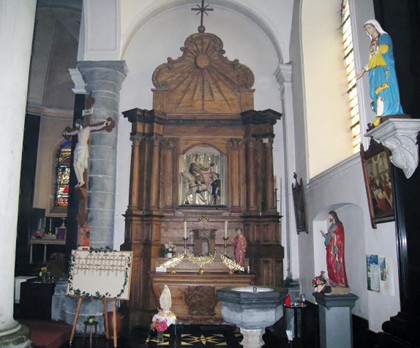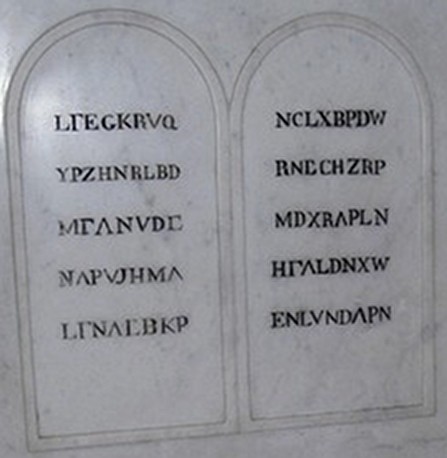I’ve just had some nice emails from Belgian writer Dirk Huylebrouck, whose article on the mysterious cryptograms in Moustier church is (today) appearing in popular Belgian science magazine EOS. Dirk’s article has some great photographs, and even includes some insights from codebreaker Jarl van Eycke (whom readers here may know as jarlve and/or from the deservedly famous Zodiac decryption). It’s a nice piece of work, well illustrated and well laid out, one which I heartily recommend to all my Belgian readers.
And here’s the article…
And even better, here’s a PDF of Dirk’s English translation of his own article. Modestly, he asked whether I would prefer to edit it a little: but it’s actually a very clear and entertaining read just as it is, and all that my well-meaning edits would probably achieve would be to lose both his voice and the article’s charm.
Dirk also suggested that I might like to include images of his photos of Moustier’s twin altars here, simply because there are so few of these on the Internet. I am of course more than happy to oblige (click on this for a decent-sized resolution, both images are (c) 2022 Dirk Huylebrouck):
Finally, the interesting bit…
If I have even a small criticism, it would be that the article gives perhaps a little too much space to Rudy Cambier’s Nostradamus-based Moustier theory (which I covered here back in 2013). But in the end you can’t deny it’s a Belgian theory, so I guess Dirk had plenty of reason to indulge it just a little for EOS. 😉
Of course, even though his article captures much of the spirit of the Moustier cryptograms, Dirk is such an eminently sensible chap that he doesn’t hazard his own (inevitably doomed) guess as to what is going on. To be fair, Jarl’s crypto insights – for example, that there are far fewer letters repeated on each line of carved text than you might generally expect – do seem to run directly counter to just about any natural language hypothesis you might have about any possible underlying text. So perhaps there are fewer sustainable (supposedly) “common-sense” readings here than you might otherwise think.
The article also highlight’s Philippe Connart’s suggestion of a possible link with 10th century lettering found at the abbey of Saint-Amand-les-Eaux (40km away). All the same, that does make me wonder whether what we are looking at in Moustier might be an (imperfect) copy of a much older carving, which itself had become worn and illegible over time, leaving us at least “twice removed” from the original.
Dirk’s collaborator Evelyn Bastien (who translated his article into French) felt compelled to add the following open question: “Even if it’s an ‘exercise’, wasn’t it just as easy to engrave a simple prayer, rather than incoherent letters?” This was in response to a theory I once proposed that the ragged nature of the Moustier lettershapes suggested that it might just have been some kind of mason’s practice. And Evelyn’s point is sensible and well-made, because that theory implies a double mystery – not only did someone carve mysterious letters, but also someone else erected those same mysterious letters in their church.
But to be fair, that double mystery is what sits right at the heart of the Moustier enigma: for the challenge to our minds isn’t just that someone made the cryptograms at all, it’s also that a church community then valued them sufficiently to celebrate its own faith right alongside those cryptograms.
In the end, it’s entirely true that all attempts so far to resolve one of this linked pair of durable mysteries have thrown little (or indeed no) light on the other one. But maybe EOS’ readers will prove to have some interesting ideas that have so far evaded us all… here’s hoping!




